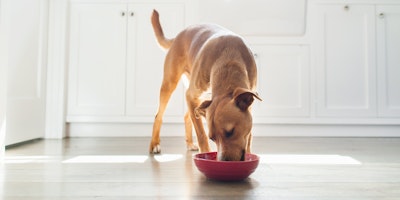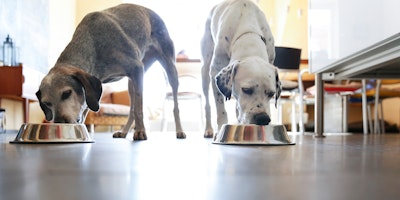
How to Use Dog Treats for Training, Bonding & Rewarding

One of the many things that brings dogs and people together is dog treats. We’ve got them, dogs want them.
Treats help dogs and people communicate, they help dogs learn, and they are a bargaining chip that can be mutually beneficial for both dog and dog owner alike. Whether you’re using dog treats for training or giving them a well-deserved snack, here are some of the ways dog treats can help strengthen your bond.
Dog Treats for Training
Most dogs are eager to please, but to get them to give you their full attention, it helps to have some treats on hand. If you’re using them for training purposes, choose small treats or break larger treats into smaller pieces so they can be eaten quickly, as you’ll dole out several per session.
Associate treats with positive words such as “good” or “yes” and feed them immediately after they engage in good behavior or follow a command, so they know why they’re being rewarded.
Dry kibble works as a reward for some dogs, but others might not be quite as excited. To ensure they’re extra motivated to learn, you can try high-value dog treats to see if that works better. Examples of high-value dog treats are treats made from tasty meats like poultry and beef or small pieces of cheese.
To make sure your dog doesn’t become too treat-obsessed, substitute other rewards like belly rubs, playtime activities and praise over time. That way they’ll associate good behavior with positive interactions beyond just treats.
How Many Treats Per Day for a Puppy?
Falling in love with your new puppy means giving them lots of cuddles, playtime and treats, but how many treats should you give your puppy? There’s a happy medium between giving your puppy treats for training purposes or a quick snack and loading them up with too many calories.
A simple rule of thumb is the amount of treats you give your puppy should not exceed 10 percent of their daily caloric intake, or you can look for complete and balanced treats.
Another option for treats is to give dogs smaller meals, then use pieces of their regular food throughout the day as treats. This will help you measure their caloric intake correctly.
Although puppies will always be excited over getting a treat, praise and affection can also be effective ways to reward your puppy throughout the training process, so you don’t have to rely solely on treats.
How Many Treats Per Day for an Adult Dog?
If you’re asking yourself “How many dog treats should I give my dog a day?” the answer is similar to how many treats you should give your puppy. The number of treats, including high reward dog treats, should not exceed 10 percent of a dog’s total daily calories.
High-value dog treats are typically higher in calories, so they should be given sparingly. Depending on your dog’s size, one or two high-value treats should be the maximum. Treats for training can be given out in higher amounts. Just don’t exceed the 10 percent rule.
When considering this, keep in mind that the caloric needs of a less active dog will be different from one with a lot of energy. If you’re uncertain about what your dog’s or puppy’s calorie, food or treat intake should be, consult with your veterinarian.
Healthy Dog Treats
If you’re worried about keeping an eye on dog treat calories, don’t be too concerned. Most treats won’t cause weight gain if they are given in the right quantities.
But if you’re looking for homemade alternatives, food items like cooked lean meat, tiny bits of apple, fresh vegetables like carrots steamed broccoli or green beans are all excellent options. You can also try peanut butter, but make sure it contains no salt, sugars or sweeteners like xylitol.
Since not all dog treats are created equal, a bit of insight into which dog treats are healthy for your dog is in order. Fruits like bananas, apples and blueberries contain vitamins and antioxidants essential to your dog’s health. Just remember that the sugar content can cause digestive issues and long-term health concerns if you don’t keep their fruit intake to a minimum.
You can also give your dog certain vegetables like green beans, carrots, broccoli and more. Certain nuts and even yogurt are healthy dog treat alternatives.
How to Choose Healthy Dog Treats
When roaming the pet food aisle for treats with the proper nutrition for your dog, make sure you’re choosing low-calorie dog treats. If you do buy high-calorie treats or larger treats, break them into smaller pieces and use them as high-value treats when needed.
Make sure you choose dog treats made from high-quality ingredients that are low in sugar and fat content. Ingredients like pumpkin, carrots, whole grains and quality single-source proteins like fish, beef and chicken are great options for your dog. Make sure you feed them in bite-sized portions and nothing larger.
For more dog food tips from our experts, visit our Pet Expertise page.
Related articles


Earn myPurina Rewards with Every Purchase
Use your points for treats, toys, and gift cards with myPurina app.

